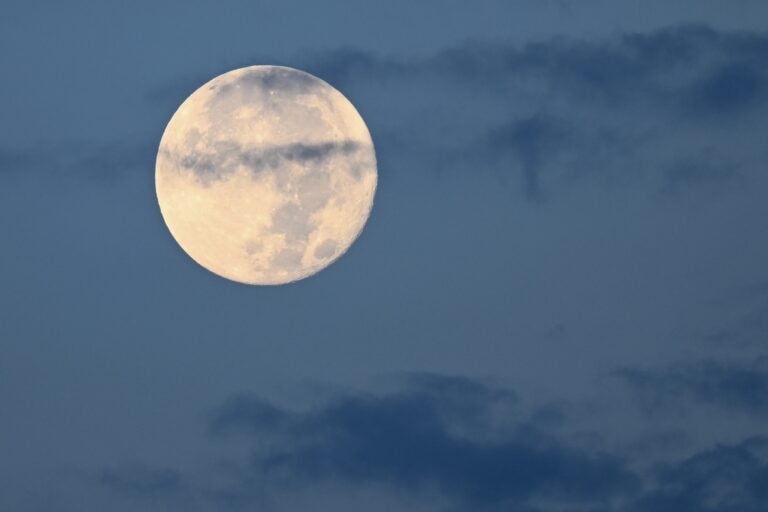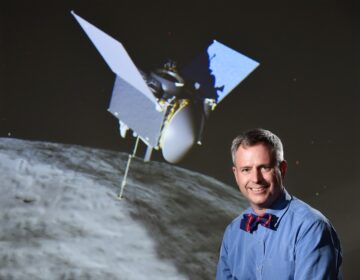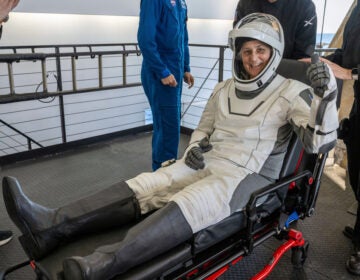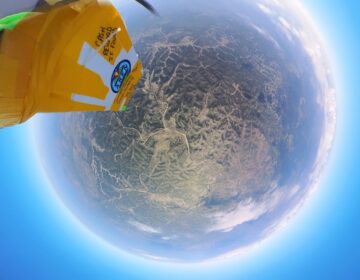What to know about Monday’s blue supermoon
The next blue supermoon will not happen until 2032, but supermoons occur more frequently.

The sturgeon supermoon over Vanderbilt University's West End Tower in Nashville, Tenn., in August 2023. (Patrick T. Fallon/AFP via Getty Images)
On Monday night, serious moon viewers may notice something different about the moon — if you look hard enough.
The full moon will be a blue supermoon, a celestial occurrence that combines two events: a supermoon, which is when the moon is closest to the Earth; and a blue moon, the third of fourth full moons in a single season.
The cosmic event usually happens about once every 10 years, but there was a super blue moon last August as well. NASA determined that the moon had met the criteria for this seemingly rare event two years in a row.
How to see Monday’s blue supermoon
Monday’s supermoon will reach its full peak at 2:26 p.m. EDT, according to NASA, but you might not even notice the difference that night if you aren’t careful.
“I personally can’t tell the difference between a supermoon and a regular moon,” Fred Espenak, a scientist emeritus for NASA’s Goddard Space Flight Center, told Morning Edition. “And I’ve been looking at the moon all my life.”
If you’re after a large moon view, you can watch the moon rise or set in your area. The moon will appear bigger if you watch it rise in the east, or watch the moon set in the west. The larger moon, combined with foreground objects in your area will create a “moon illusion” and make the moon appear bigger.
You can check the local rising and setting times for your area using the U.S. Navy’s Moonrise calendar.
If you want a more detailed view of the moon, you can use a telescope or a pair of binoculars. The moon will appear full for three days, according to NASA, but only Monday’s will be a true supermoon.
What makes a moon super? What makes it blue?
Much like the Earth does not orbit the sun in a perfect circle, the moon does not orbit the Earth in a perfect circle. The moon’s orbit is an ellipse shape which results in an oval-like orbit around our planet. This means that at times, the moon is closer to the Earth. When the moon is both full and closest to the Earth, it’s known as a supermoon, because the moon appears brighter and larger than it is normally.
Supermoons occur about three to four times a year. The term was first coined in 1979, but astronomers will call this phenomenon a perigean full moon. Perigee is the scientific term for the closest point of a moon’s orbit. The average perigee is about 226,000 miles from the Earth.
A blue moon is a little less complicated: It has to do with the frequency of the full moon. There are two definitions of blue moons: monthly and seasonal.
A monthly blue moon is when we see two full moons in one month. Monday’s full moon is a seasonal one: It is the third full moon in a season that has four full moons. A typical season only has three full moons, but summer 2024 has four.
Monday’s moon is also referred to as a sturgeon moon, a term originating from Native Americans, who called August’s full moon the sturgeon moon after the fish, which could be caught in the Great Lakes and Lake Champlain during this part of the summer.
Other supermoons happening this fall
If you don’t catch Monday’s blue supermoon, you will be able to see three more supermoons this year. None of them will be a blue supermoon, but they will still appear brighter and larger than other full moons.
Next month’s supermoon will be on Sept. 18. It will be a super harvest moon. It’s called a harvest moon because of its proximity to the autumnal equinox: An equinox is when the Earth’s equator is most directly in line with the sun. This supermoon will also undergo a partial lunar eclipse.
The next two supermoons will occur on Oct. 17 and Nov. 15.
The next seasonal blue supermoon will occur in 2032, while the next monthly blue supermoons will occur in 2037, according to Space.com.
WHYY is your source for fact-based, in-depth journalism and information. As a nonprofit organization, we rely on financial support from readers like you. Please give today.




